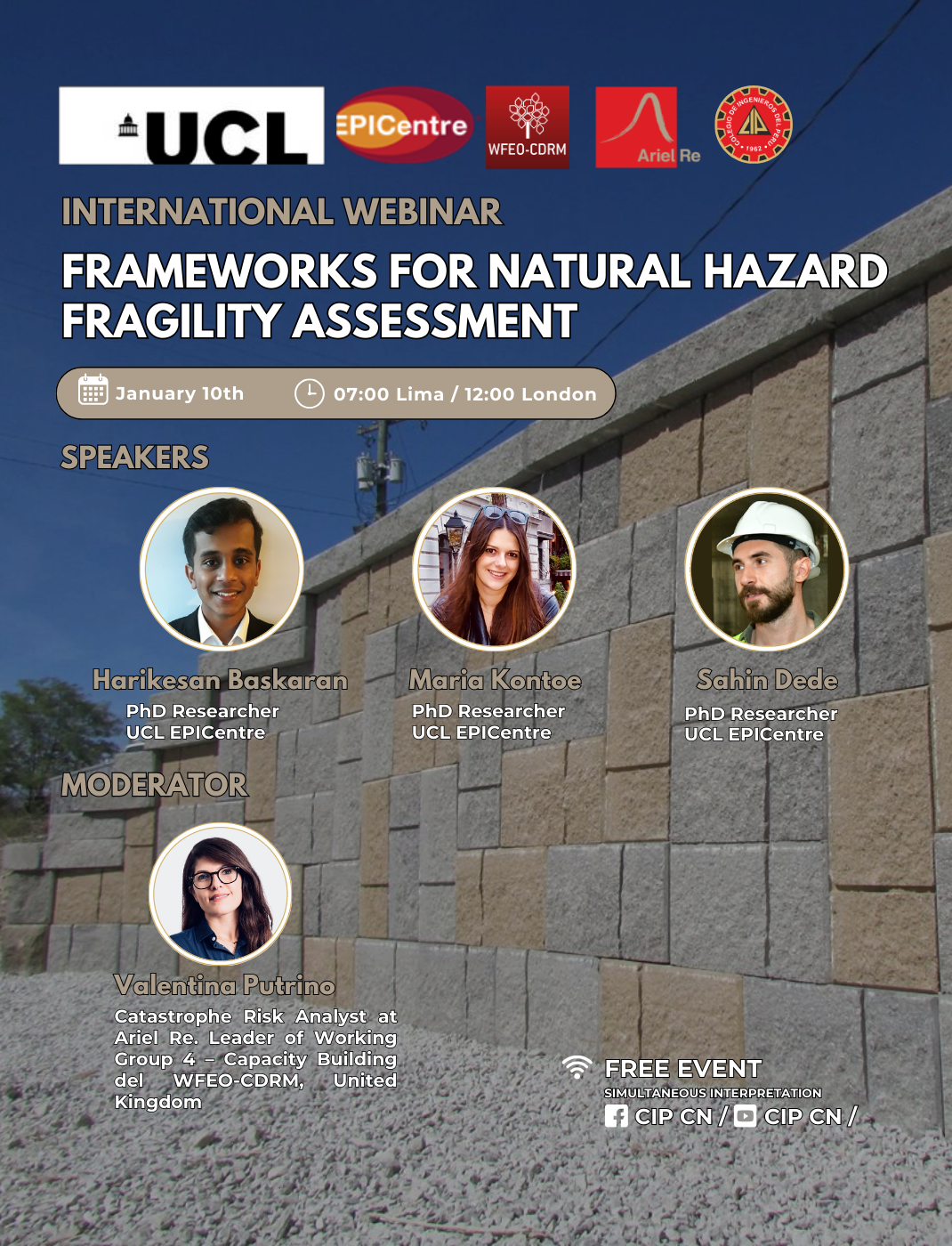
The WFEO Committee on Disaster Risk Management (WFEO-CDRM) and the Peruvian Engineers Association (CIP) are organizing the webinar “Frameworks for natural hazard fragility assessment” that will be held on January 10th, at 07:00 AM in Lima and 12:00 PM in London.
The access link is available in this page.
Welcome
- José Macharé Ordoñez – Chair of the WFEO-CDRM, Peru
Introduction
- Valentina Putrino – Catastrophe Risk Analyst at Ariel Re. Leader of Working Group 4 – Capacity Building of the WFEO-CDRM, United Kingdom
Case of study
- Maria Kontoe – PhD Researcher | UCL EPICentre – An Analytical Framework for Assessing the Impact of Dry Granular Flows on Structures
- Sahin Dede – PhD Researcher | UCL EPICentre – Seismic Vulnerability of High-Rise Tunnel-Form Buildings
- Harikesan Baskaran – PhD Researcher | UCL EPICentre – Assessing the natural hazard vulnerability of the green economy
Comments and questions
- From experts and the general public
Closing
- Valentina Putrino – Catastrophe Risk Analyst at Ariel Re. Leader of Working Group 4 – Capacity Building of the WFEO-CDRM, United Kingdom
In the first presentation of this session, Maria will introduce the fundamental aspects of a novel analytical framework for assessing the performance of reinforced concrete (RC) structures subjected to dry granular flows. The soil pressures acting on rigid structures are initially identified through a 3D Material Point Method (MPM) model of a flume experiment. The model is adapted to simulate a building by replacing the retaining wall with a reduced-width obstacle, allowing for the investigation of the impact of blockage ratio on force distribution. The recorded soil forces are then applied to a 3D RC frame building in OpenSees, facilitating both static and dynamic analyses. The results demonstrate the adequacy of adopting a practice-oriented static approach for evaluating landslide induced structural damage. Maria will conclude her presentation by highlighting the significant differences in structural behavior under landslide and seismic loads.
Sahin will follow this presentation by addressing the findings of an extensive research project on the seismic vulnerability of high-rise tunnel-form buildings, a prevalent building typology used in mass housing projects in seismically active regions, such as Türkiye. His ongoing research project synthesizes a sophisticated numerical model, multi-staged verification protocols, and post-earthquake field observations to examine the seismic performance of tunnel-form buildings. The salient structural features of the typology, nuances in numerical modelling, observed damage mechanisms following the 2023 Türkiye earthquakes and an overview of the fragility framework adopted in this research project will be discussed.
Finally, Harikesan’s presentation will cover the growing need to understand the vulnerability of the green economy to natural hazard events. Given the complexity and low exposure history of these assets, assessing their vulnerability poses a major challenge for the insurance industry. In his talk, Harikesan will provide an overview of a systematic literature review conducted as part of a UCL-AXA collaboration, which determined the suitability existing literature for this purpose. It will be followed by an overview of his current PhD research looking at the vulnerability of onshore wind turbine gearboxes to extreme wind events – a critical area in need of further research.
For more information:
